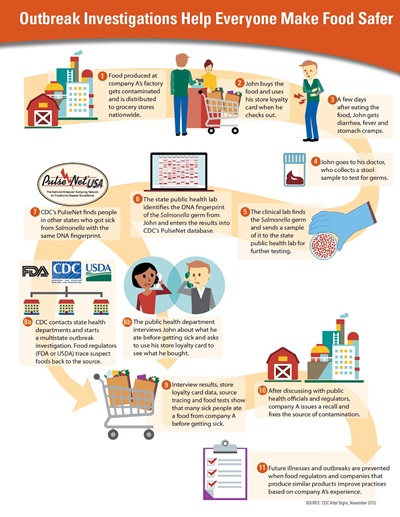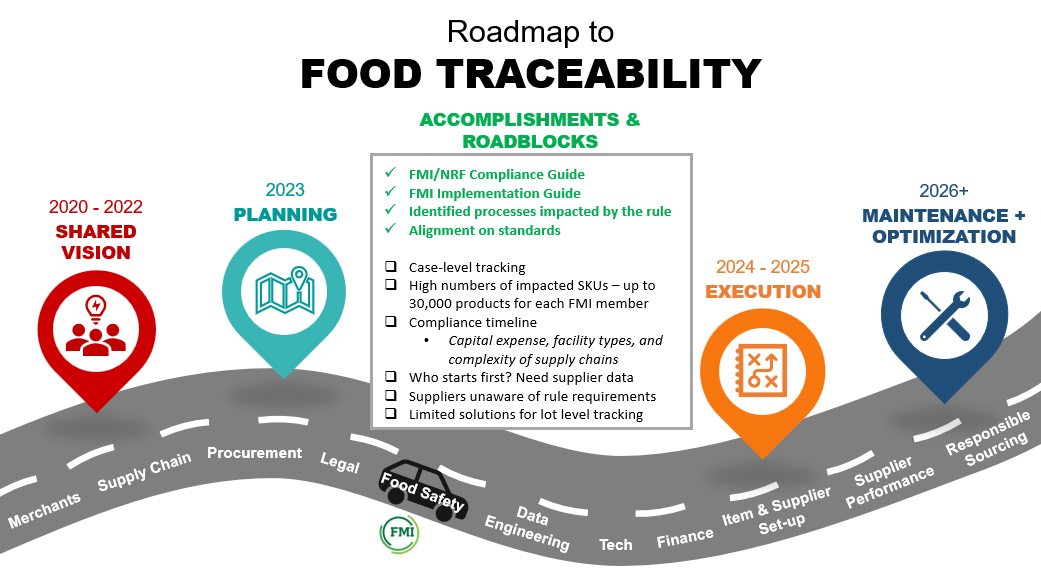By: Hilary Thesmar, PhD, RD, FMI Vice President, Food Safety Programs, Food Marketing Institute

When you turn on the TV, open a newspaper or a news app on your iPad, it may seem as if the numbers of foodborne outbreaks are becoming more common. There are several reasons why the incidences of large scale foodborne outbreaks have become more widespread (1) increased supply chain complexity—food travels further within a short period of time; and (2) improved detection methods.
The Centers for Disease Control (CDC) recently published its food safety Vital Signs Report. Instead of highlighting a single microorganism, this year’s report takes a more holistic approach, focusing how the food industry and local, state, and federal agencies can work together in order to stop multistate outbreaks. The Vital Signs report analyzes data from the CDC’s Foodborne Disease Outbreak Surveillance System between 2010 and 2014. The surveillance system monitors food, microorganisms, and locations of foodborne outbreaks.
Some of the key findings from the report include:
- Multistate outbreaks caused 56 percent of deaths in all reported foodborne outbreaks, although they accounted for just 3 percent of all such outbreaks from 2010 to 2014;
- An average of 24 multistate outbreaks occur each year, involving between 2-37 states;
- Tracebacks led to product recalls in 46 percent of multistate foodborne outbreaks;
- Salmonella, STEC, and Listeria monocytogenes were the cause of the most multistate outbreaks; and
- 15 percent of outbreaks were linked to imported foods and account for 18 percent of the foodborne illnesses.
Moving forward, what can the food industry do? According to CDC the food industry can:
- Keep records to trace foods from source to destination;
- Use store loyalty card and distribution records to help investigators identify what made people sick;
- Recall products linked to an outbreak and notify customers;
- Choose only suppliers that use food safety best practices, (such as SQF Certified);
- Share proven food safety solutions with others in industry;
- Make food safety a core part of company culture; and
- Meet or exceed new food safety laws and regulations.
FMI works to provide solutions to our members in order to protect public health. Here are a number of resources FMI has developed to help address many of the action steps the CDC outlined in its Vital Signs Report.
- Working with the Produce Industry to develop the Produce Safety Best Practices Guide for Retailers.
- Created a Generic Food Safety Plan for Distribution Centers to help Retailers comply with the FSMA Preventive Controls Rule.
- Partnered with ReposiTrak® to provide a food safety traceability system for food retailers.
- Developed Guidance for Retailers: Product Recalls.
- Collaborated with GMA and GS1 to create Rapid Recall Express, a downloadable, fillable form that applies industry expertise and best practices to standardize recall and withdrawal notifications.
- Developed the SafeMark® comprehensive, interactive training program for the retail food industry to promote a food safety culture.
- Developed a Listeria Action Plan to assist retailers on preventing and controlling Listeria monocytogenes in retail delis.
- FSIS webinar for FMI on how shopper cards are used in illness outbreak investigations
Reference:
Centers for Disease Control and Prevention. Vital Signs: Multistate Foodborne Outbreaks — United States, 2010–2014. MMWR 2015; 64(43): 1221-1225.


 Industry Topics address your specific area of expertise with resources, reports, events and more.
Industry Topics address your specific area of expertise with resources, reports, events and more.
 Our Research covers consumer behavior and retail operation benchmarks so you can make informed business decisions.
Our Research covers consumer behavior and retail operation benchmarks so you can make informed business decisions.
 Events and Education including online and in-person help you advance your food retail career.
Events and Education including online and in-person help you advance your food retail career.
 Food Safety training, resources and guidance that help you create a company food safety culture.
Food Safety training, resources and guidance that help you create a company food safety culture.
 Government Affairs work — federal and state — on the latest food industry policy, regulatory and legislative issues.
Government Affairs work — federal and state — on the latest food industry policy, regulatory and legislative issues.
 Get Involved. From industry awards to newsletters and committees, these resources help you take advantage of your membership.
Get Involved. From industry awards to newsletters and committees, these resources help you take advantage of your membership.
 Best practices, guidance documents, infographics, signage and more for the food industry on the COVID-19 pandemic.
Best practices, guidance documents, infographics, signage and more for the food industry on the COVID-19 pandemic.
